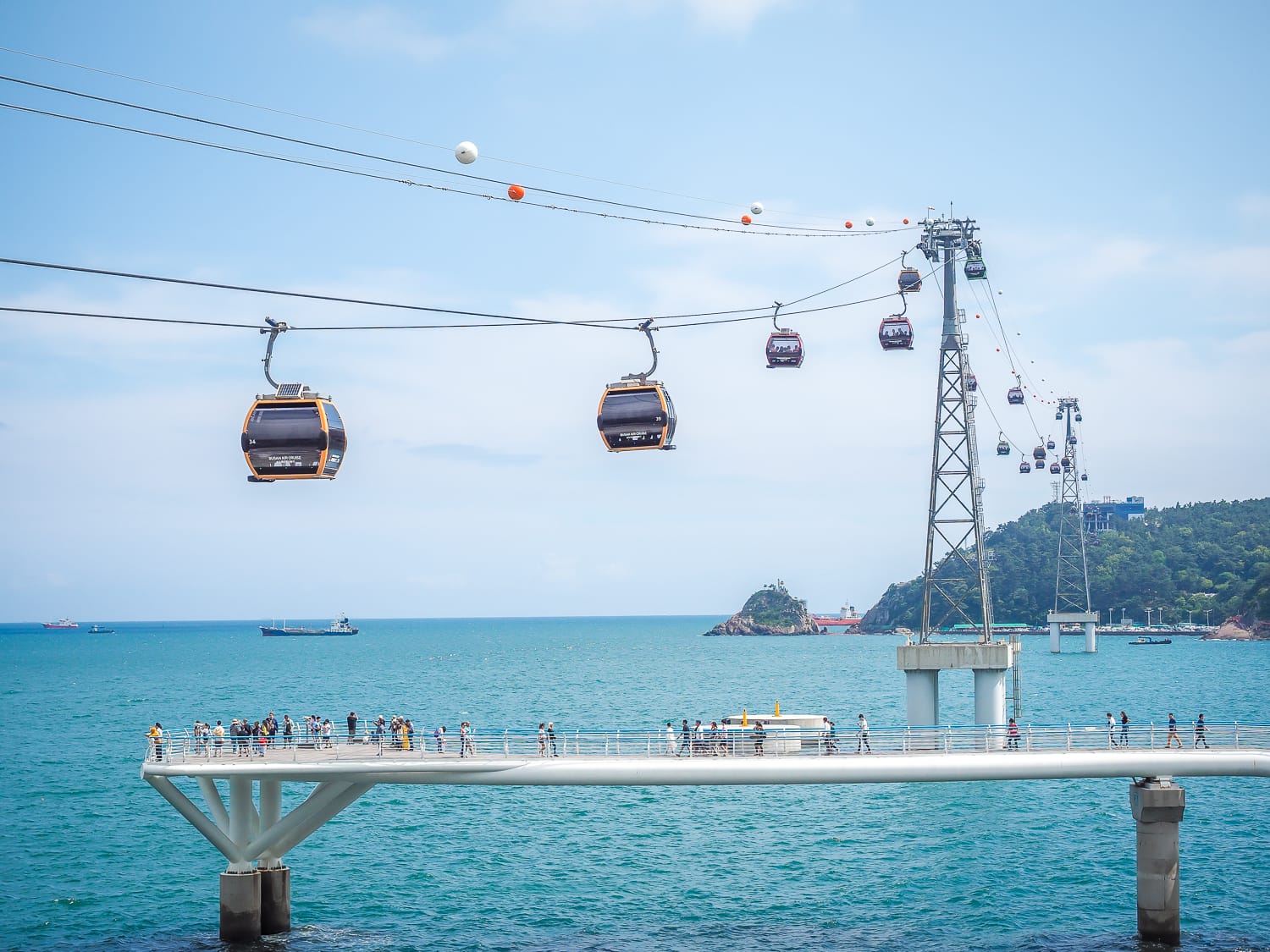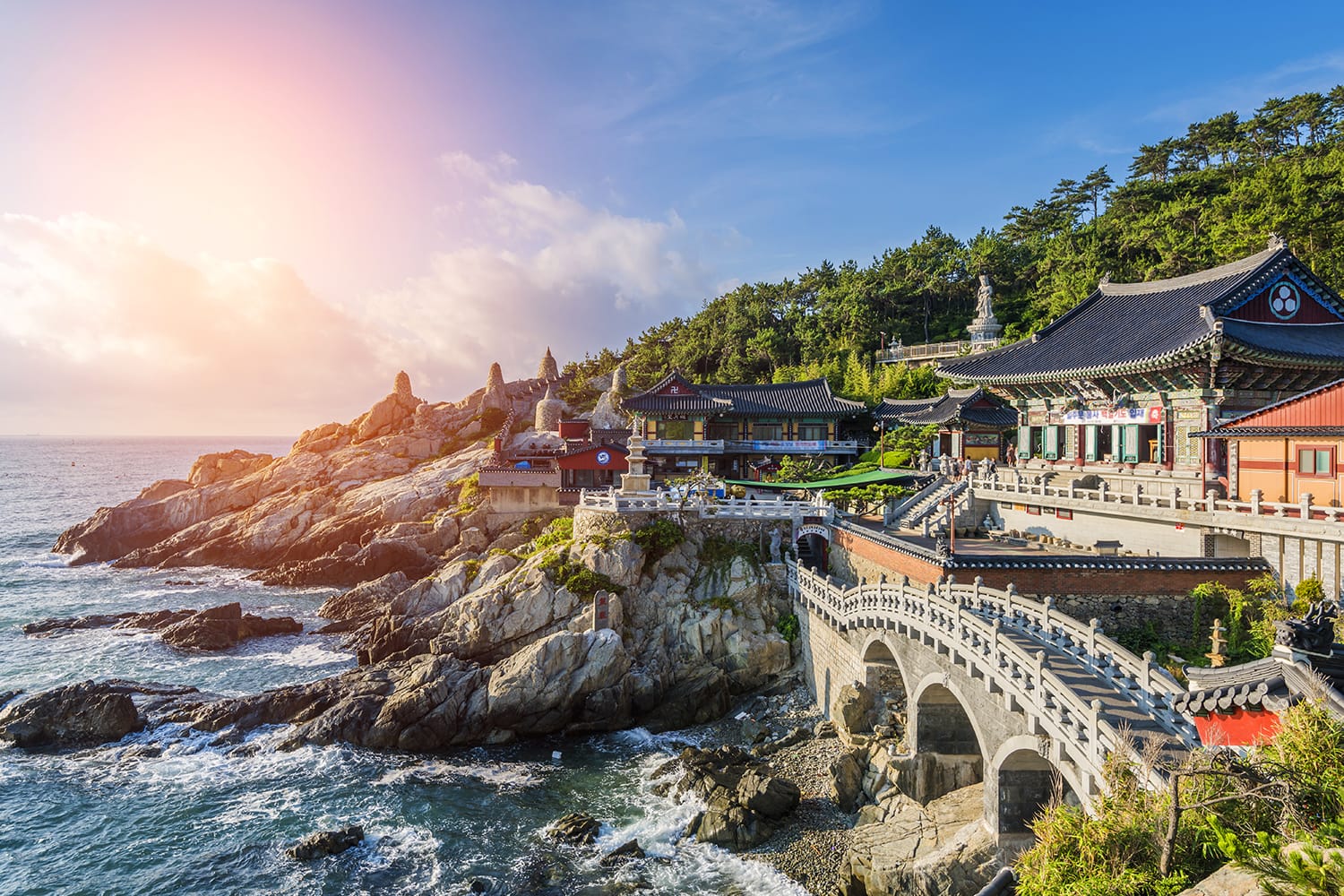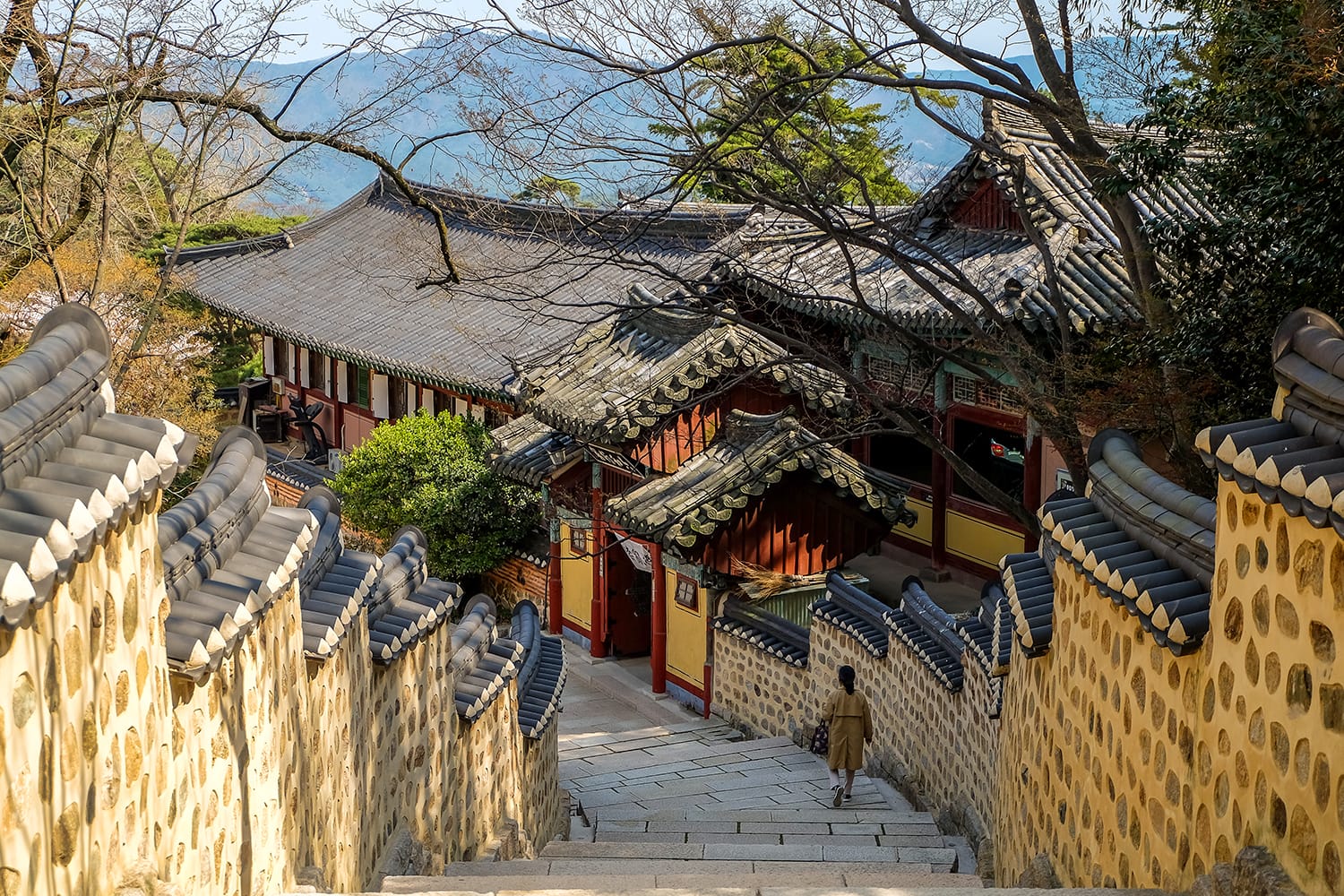Road Affair is reader-supported and may earn commission from purchases made through links in this article.
As South Korea’s second largest city, Busan is often overshadowed by Seoul. However, Busan is without a doubt my favorite city in South Korea.
This large, spread out port metropolis seems to have it all. From one-of-a-kind temples and death-defying coastal walkways, to the country’s largest markets and most popular beaches.
Below I’ve prepared a comprehensive Busan guide, including how to get to Busan, how to get around Busan, where to stay in Busan, what to eat in Busan, and the best things to do in Busan.
The info and photos you’ll find below come from three trips I’ve made to Busan in the last 10 years. For even more ideas, feel free to check out my 50 favorite things to do in Busan.
Contents
Getting to Busan
Many international flights fly directly to Busan’s Gimhae International Airport (PUS). If you’re flying from a nearby Asian country, you may find that there are some incredibly cheap flights to Busan. Last time I went, I paid less than $200 return from Taipei! Take a look at Skyscanner to compare flights from your destination.
If you’re coming from Seoul, the capital of South Korea, the fastest and most convenient way to get to Busan is to take the KTX, Korea’s high-speed rail. A one-way ticket costs around 60,000 won (50 USD) and the journey takes 2.5-3 hours.
Seats on the KTX can be reserved up to one month in advance, but you can always buy a standing ticket, even at the last minute. If you plan to also return to Seoul by KTX, getting a rail pass will work out to be cheaper.
Surprisingly, domestic flights from Seoul’s Gimpo airport to Busan are often even cheaper than the KTX, but you have to factor in the time and money getting to and from the airports.
Slower train options include the ITX (4.5 hours, 45,000 won) and Mugunghwa train (5.5 hours, 28,000 won).
All trains can be booked online or at the ticket booth in any train station.
There are also several buses each hour from Seoul’s Gyeongbu station to Busan, these take about four hours, depending on traffic, and range from 23,000 – 45,000 won.
Note that many buses arrive and depart Busan from Central Bus Station at Nopo subway station, which is actually located in the far north of the city. Do not confuse Nopo with Nampo, the popular tourist area with many popular attractions in southern Busan.
Bus tickets can be purchased from the ticket windows at Gyeongbu station in Seoul or Central Bus Station in Busan right up to the last minute, depending on seat availability. If you’re planning to travel at a busy time, it’s best to get a ticket a few days in advance.
Getting Around Busan
Busan’s excellent subway system is the lifeline of the city. Given that Busan is extremely spread out, with many neighborhoods and top attractions lying in opposite ends of the city, often separated by mountains, rivers, and even bays, you will definitely be relying a lot on the subway to get around.
The Busan subway consists of four main lines. Line 1 (the orange line) runs from north to south, connecting the Central Bus Station in the north to Busan Train Station and Nampo neighborhood in the south.
Line 2 (the green line) runs west to east, connecting the airport (via the new Busan Gimhae Light Rail line) in the west, to the popular beach districts of Gwangan and Haeundae in the east.
Seomyeon, Busan’s central business district, is where the two lines connect in the middle, and is Busan’s most fashionable district and the best place to party or go shopping.
It is less likely that you will use Line 3 (brown) and Line 4 (blue) as a traveler.
Some popular Busan attractions cannot be accessed by subway, which is where buses come in. Some attractions which you need to ride the bus to reach include Gamcheon Culture Village, Songdo Beach & Cable Car, Oryukdo Skywalk, and Haedong Yonggungsa Temple (see below for more info on all those).
For the subway and buses, the most convenient way to pay is by swiping an IC card. There are numerous IC cards available, including Cashbee, Hanaro, T-Money, and Korea Tour Card, which you can purchase from convenience stores or from inside subway stations.
When taking a bus, board at the front and swipe your card. Get off from the back door. You do not need to swipe again on exit. If you are transferring to the subway or another bus, you get a discount (subway) or free ride (bus) within 30 minutes of. To activate this deal, you’ll need to swipe your card again as you’re getting off the first bus.
Taxis are also plentiful and cheap in Busan. The starting fare is 3300 won (USD 2.80). Note that regular taxis come in many colors (usually gray, white, or orange), but beware that the black ones with a yellow sign on top are “deluxe” ones which cost more, with no major difference besides being slightly nicer inside.

Where to Stay in Busan
With its high concentration of popular sights, including proximity to Gamcheon Culture Village, Nampo is the best place to stay in Busan. It’s also the best place to be if you are a foodie. Boutique Hotel YTT Nampo and Aventree Hotel Busan are some of the highest rated hotels in this area.
You may also want to consider Yeongdo Island, which is just across the bridge from Nampo. That’s where I stayed and some hotels, like the Value Hotel Busan and Lavalse Hotel, offer an incredible view of Nampo and the rest of Busan.
The only downside of the above is that they are quite a ways from some of Busan’s other famous sites, like Beomeosa, Haedong Yonggungsa, and Haeundae beach.
For sheer convenience Seomyeon, the commercial center of the city, is at the intersection of the two main subway lines and is closer to the airport. Lion Hotel is a great option in his neighborhood.
Beach lovers may choose to stay at Gwangalli or Haeundae Beach, but these neighborhoods are a little far removed from the city’s other attractions. If don’t mind traveling a little further in exchange for being directly on the beach, consider staying at Best Western Haeundae Hotel or Canvas Hostel.
For more accommodation options in Busan check out Booking.com. They continuously offer the best rates and their custom service is on point.
What to Eat in Busan
As a port city, it’s no surprise that Busan is famous for its seafood. People in Busan really, really like their seafood, and you can find it everywhere.
A good place to start is Jagalchi Fish Market and the streets surrounding. Gamji Beach, near Taejongdae Resort Park, and Cheongsapo Harbor, near Haeundae Beach, are two spots where you can dine on seafood while looking out at the sea.

Another local seafood obsession is eomuk, or fish cakes. These come in various shapes, sizes, and flavors (my favorites were chili pepper flavor and the cheese-stuffed ones), and can be seen everywhere served on sticks soaked in a delicious broth. Just walk up to the stall, help yourself, then pay when you’re done!
Samjin Eomuk, a famous chain serving eomuk to go, is a local institution, and the Samjin Eomuk Headquarters and Eomuk Museum on Yeongdo Island can’t be missed.

Busan is also famous for its street food. Besides the usual street-side snacks you can find across the country, one to-die-for Busan-only specialty is ssiat hotteok, deep-fried pancakes stuffed with seeds, nuts, brown sugar syrup, and cinnamon. The best place to try them is BIFF Square.
Another local specialty I personally loved was milmyeon, or flour noodles, which in summer are served in an icy cold and incredibly flavorful broth.
Best Things to Do in Busan
Busan offers plenty of things to do and see, but below are some of the best places to visit in Busan, so make sure to add them to your Busan itinerary.
Recommendation: See the best of Busan on a full-day sightseeing tour with a driver and guide. Attractions include Taejongdae, Gamcheon Culture Village, and more. You can book the tour here.

1. Jagalchi Fish Market
Jagalchi is South Korea’s largest fish market and one of Busan’s most popular attractions. Be prepared to spot sea creatures you didn’t know existed!
Many visitors stroll through the ground floor of the seven-story structure and explore the seafood markets in the surrounding streets.
If you want to sample the seafood, choose what you’d like and take it up to the second floor to be prepared in one of the many restaurants, or simply order from one of the restaurants’ menus.

2. Nampo-dong (Nampo Neighborhood)
Besides Jagalchi Market, the Nampo and neighboring Gwangbok neighborhoods contain several more of the city’s most famous sites.
Near Jagalchi Fish Market, BIFF Square (Busan International Film Festival Square) is Busan’s version of Hollywood’s Walk of Fame, but with awesome street food.
Continuing past BIFF Square, head to Gwangbokdong Food Street, where elderly Korean women serve tasty, cheap noodles to customers sitting on low chairs in the middle of the narrow lane.
The food street leads into Gukje Market, the largest traditional market in South Korea. Don’t miss neighboring Tin Can Alley, another very large market next to Gukje that is focused entirely on food.
Last but not least, head to Yongdusan Park and ascend Busan Tower for awesome 360-degree views of Busan.

3. Taejongdae Resort Park
South of Nampo lies Yeongdo Island, connected to the mainland by a bascule bridge which can lift to let large ships into Busan Port. At the southern tip of Yeongdo Island, facing the South Sea, Taejongdae Resort Park is one of the most popular places in Busan to take in coastal views.
A small train on wheels carries visitors on a loop road to two coastal lookout points offering awe-inspiring views and a lighthouse. A third stop provides access to a serene forest temple.

4. Gamcheon Culture Village
Gamcheon has skyrocketed to fame in recent years and is one of the most photographed places in Busan. The old neighborhood built for Korean War refugees has been converted into a super colorful art-focused community.
Looking down over the rainbow-colored houses and getting lost in the narrow, art-filled lanes of Gamcheon Village is a Busan experience you simply cannot miss.

5. Songdo Beach and Cable Car
The most central of Busan’s seven main beaches, Songdo is just a short bus or taxi ride from Nampo. Besides the beach itself, which is good for swimming, Songdo is famously the site of the first cable car in Korea, which was built in 1964, closed in 1988, and reopened in 2017.
Songdo also has a popular skywalk over the sea called Songdo Cloud Trails near the cable car station. At the other end of the beach there’s a lesser-known red coastal walkway which leads to Amnam Park at the tip of the peninsula, which is the same place where the cable car terminates.

6. Oryukdo Skywalk
If you still want more sea views after visiting Songdo Cloud Trails, head over to Oryukodo Skywalk, a higher (and more terrifying) walkway over the sea.
This see-through walkway is relatively short, but offers epic views of the Oryukdo Islands, right at the point where the South Sea meets the East Sea.

7. Gwangalli Beach
True beach lovers can’t miss Gwangalli and Haeundae beaches. Gwangalli is closer to the city center so it’s slightly more convenient to reach. Between the two, Gwangalli is also a little more laid back, with a relaxed city-by-the-sea vibe.
Come here for a casual early evening stroll, a cold beer at one of the many pubs lining the beachside avenue, or to set off fireworks from the beach at night, which are sold from local convenience stores.
Perhaps the best part of Gwangalli Beach is the awesome view of Gwangan Bridge, one of Korea’s longest, which runs across the sea in front of the beach.

8. Haeundae Beach
Haeundae is South Korea’s most popular beach. In summer it is packed with beach umbrellas, though visitors flock to it throughout the entire year.
Haeundae is decidedly more fashionable than Gwangalli, and Haeundae neighborhood contains a high concentration of luxury resorts, hip cafés, art galleries, spas, a popular aquarium, and the Haeundae Food Market.
Don’t miss The Bay 101, an upscale yacht club with epic city views across the water, especially at night. Entry to enjoy the view is free!

9. Haedong Yonggungsa Temple
This ancient temple by the sea has grown to become one of Busan’s most popular attractions in recent years, despite its somewhat remote location.
In a country where most Buddhist temples are in the mountains, Haedong Yonggungsa, the “Dragon Palace Temple,” is totally unique, and iconic of Busan.
The temple can be overrun with crowds, so try to visit in the early morning, or even better, go for sunrise.

10. Beomeosa Temple
While Haedong Yonggungsa may be more popular nowadays, true temple enthusiasts can’t miss Beomeosa, Busan’s most important temple.
The temple is beautifully situated on the slopes of Mt. Geumjeong, the highest in Busan, and dates back to 678 AD.
Beomeosa is the only temple in Busan offering a temple stay program, which takes place on Saturday nights only. You can book a spot online two months in advance. This was personally my favorite experience in Busan!

Bonus: Gyeongju
Gyeongju, the capital of the ancient kingdom of Silla, has the most well-preserved and beautiful UNESCO Heritage Sites in South Korea, and is often referred to as “the museum without walls”.
It’s only an hour’s drive or bus ride north of Busan, making it the perfect day trip for those interested in Korean history and culture. Buses to Gyeongju leave about every 15 minutes from the Central Bus Station, but to get the most out of this day trip, I highly recommend you book a tour with an expert guide.
Now that you’ve gone through this detailed Busan travel guide, you should be sufficiently prepared for your trip to Busan. It’s time to book your flight and find out why Busan is my favorite city in South Korea!


